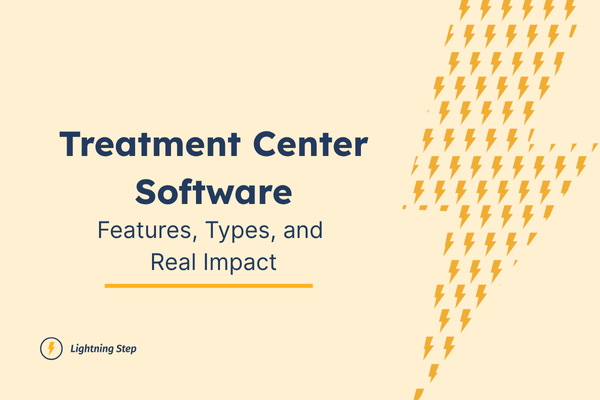
With the behavioral and mental health software market set to reach USD 2.8 billion in 2025 and the Addiction Treatment Market Size projected to grow from USD 456.77 million in 2025 to USD 522.07 million by 2033, at a CAGR of 6.91%, treatment centers face mounting pressure to modernize their operations. The right technology can slash administrative burden, reduce staff burnout, and drive measurable gains in patient outcomes. Lightning Step's AI assistant, LIA, helps clinicians save over 12.5 hours monthly on documentation tasks.
Treatment center software is a specialized platform designed to manage both clinical and administrative functions in behavioral health, addiction treatment, and mental health facilities. These systems unite electronic health records, appointment scheduling, billing processes, and reporting capabilities into one cohesive solution.
The software serves as the operational backbone for treatment centers, eliminating the inefficiencies of managing multiple disconnected systems. Instead of juggling separate platforms for patient records, billing, and scheduling, staff can access everything through a single interface.
Lightning Step exemplifies this integrated approach, combining CRM, EMR, and RCM functionality specifically for behavioral health and addiction treatment centers. This unified design reduces duplicate data entry and improves communication between departments.
Electronic Health Record integration creates a comprehensive patient file that follows individuals from admission through discharge. This includes assessments, treatment plans, case notes, and outcomes data in one accessible location.
Appointment scheduling systems reduce no-shows through automated reminders via email, text, or phone calls. Advanced scheduling features accommodate multiple providers across different locations while managing complex treatment schedules.
Billing and revenue cycle management streamline insurance verification, claims processing, and payment collection. These features help centers maintain healthy cash flow while reducing administrative overhead.
Telehealth capabilities extend care beyond facility walls, allowing for remote sessions and continuous patient monitoring. This flexibility improves access to care and supports patient engagement between in-person visits.
Analytics dashboards provide real-time insights into clinical outcomes and financial performance. Staff can track key metrics like patient progress, appointment utilization, and revenue trends.
Security measures protect sensitive patient information through HIPAA compliance, data encryption, and role-based access controls. These safeguards maintain patient privacy while allowing appropriate staff access to necessary information.
Lightning Step's EMR system includes customizable workflows that adapt to different treatment modalities and AI-driven reporting that saves clinicians time on documentation tasks.
All-in-one practice management platforms offer comprehensive functionality in a single system, delivering better data flow and user experience compared to specialty add-ons that focus on specific functions like billing or telehealth. A cloud solution offers lower upfront costs and automatic updates, while on-premise delivers full control and enhanced security. Specialty-focused platforms serve addiction, mental health, and rehab centers with modules like group-therapy scheduling, craving-tracker tools, and outcome measurement dashboards, ensuring workflows match each program's needs.
Real-time data access enables multidisciplinary teams to coordinate care more effectively. Clinicians can review patient progress, medication changes, and treatment notes instantly, leading to better-informed decisions.
Telehealth integration expands access to care, particularly for patients in remote areas or those with transportation challenges. This technology also supports continuity of care during unexpected disruptions.
Predictive analytics help identify patients at risk for relapse or treatment dropout. Predictive models can identify at-risk patients early, reducing relapse rates by 20%.
LIA auto-populates clinical notes and verifies insurance in seconds, saving clinicians over 12 hours per month. This AI-powered automation handles routine documentation tasks while maintaining accuracy and compliance standards.
Patient portals and mobile engagement features keep individuals connected to their treatment team between sessions, supporting ongoing recovery efforts.
Many centers choose Lightning Step for its comprehensive implementation support and robust training resources that ease the transition to new technology.
Develop a phased rollout strategy that introduces new features gradually rather than all at once. This approach minimizes disruption to daily operations and allows staff to adapt progressively.
Organize hands-on training sessions and designate "super-users" who can provide ongoing support to their colleagues. These internal champions help maintain momentum during the learning curve. Use LIA's analytics dashboard to track documentation-time reductions and quantify staff efficiency gains during rollout.
Establish clear key performance indicators such as appointment wait times, billing accuracy, and patient satisfaction scores. Regular monitoring helps identify areas where the software is delivering value and where adjustments may be needed.
Lightning Step's continuous improvement model ensures the platform evolves with changing industry needs.
A mid-sized behavioral health facility struggled with workflow silos, manual scheduling processes, and delayed billing cycles. Staff spent excessive time on administrative tasks, reducing time available for patient care.
The center implemented Lightning Step's integrated EHR, scheduling, and telehealth modules. The unified platform eliminated duplicate data entry and improved communication between clinical and administrative staff.
Measurable outcomes included:
Key lessons included the importance of thorough staff training and the value of having dedicated implementation support throughout the transition process.
By unifying CRM, EMR, and RCM in one platform, Lightning Step delivers measurable ROI and operational agility. For example, one behavioral health network increased clean-claim rates from 75% to 93% and cut days in A/R by 40% after adopting Lightning Step's RCM tools. Assess your current system today and see how our demo can cut your admin time by 30%.
Lightning Step's comprehensive platform demonstrates how integrated solutions can address the unique challenges facing behavioral health and addiction treatment centers. The combination of clinical, administrative, and financial tools in one system eliminates many common operational pain points.
Ready to see Lightning Step in action? Request your free demo and discover how our AI-powered CRM/EMR/RCM platform can revolutionize your treatment center's operations today.



